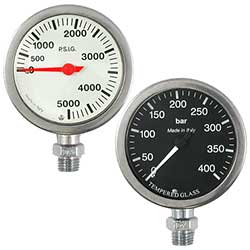No two SPG's are going to give the exact same reading. Same is true for transmitters.
They'll be in the general ballpark with a maximum accepted deviation.
Over time, the reading becomes less accurate. The bourdon tube in an analog SPG will stretch, giving incorrect readings, at which time you'll need to replace the whole SPG. And with a transmitter, the sensor can give incorrect readings due to stretching of the membrane, or compression of a spring, at which time that part will need to be replaced.
If you're finding both SPG's give wildly differing readings, try with a new one to see which one is in need of replacement or servicing. Likely the one with the highest reading will be the one that needs replacing/servicing. If you're diving with both, use the lowest of the two readings as the truth. Even if that one is off, you run the least risk of running out of gas.





